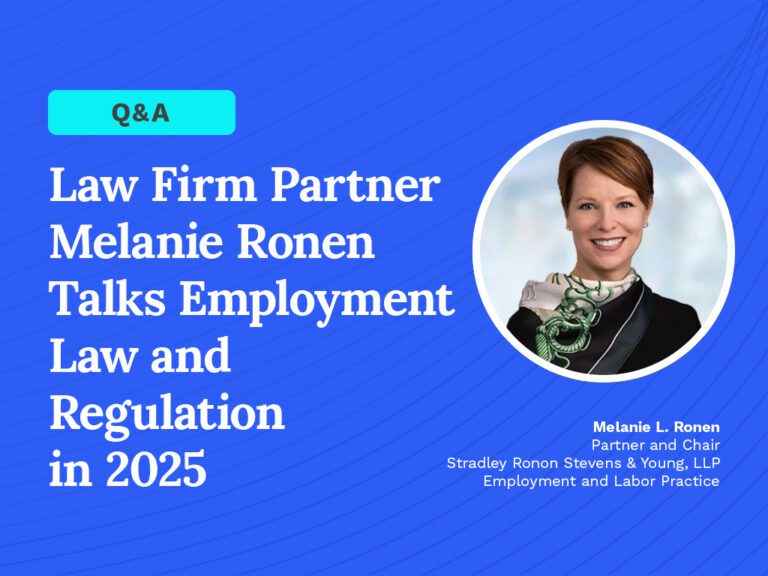Law Firm Partner Melanie Ronen Talks Employment Law and Regulation in 2025
February 12, 2025

Melanie L. Ronen is a partner and chair of Stradley Ronon Stevens & Young, LLP’s employment and labor practice. She works closely with employers to ensure compliance and mitigate risk, and when disputes arise, she helps them navigate and resolve legal challenges effectively.
Published in Today's General Counsel, March/April 2025
In this exclusive interview with Today’s Managing Partner, law firm partner Melanie Ronen talks about key employment law and regulation trends, compliance challenges, and what’s next for the workplace in 2025.
Could you walk us through some of the most significant employment law changes in California for 2025?
Melanie Ronen: There are several notable changes this year. One of the most interesting is the freelance workers’ protection law. Anyone hiring freelancers in California knows the landscape has become more complex due to case law changes and legislative responses.
Under this law, a freelance worker is an individual or sole proprietor hired to provide services over $250 per engagement or in aggregate. The law does not apply to companies hiring other companies comprised of more than one person as contractors but rather to individuals.
This law requires employers to document agreements in writing and specify payment terms, among other protections. It also includes an anti-retaliation provision, which is somewhat unique in the independent contractor space. Employers need to be mindful of these requirements when entering or renewing agreements with freelance workers.
Another important change is the amendment to the Fair Employment and Housing Act (FEHA) which prohibits discrimination based on a combination of two or more protected characteristics. California is the first state to address intersectionality specifically, and I anticipate that the courts’ handling of claims based on multiple protected classes will gain more attention with this change.
The whistleblower protection bill hasn’t changed the protections but now mandates greater transparency, requiring employers to provide additional notices. California already has extensive employee notice requirements, and this is another addition.
A new law regarding driver’s license discrimination makes it unlawful for employers to require a valid driver’s license in job postings unless driving is an essential function of the job and alternative transportation isn’t a reasonable option. Employers should review job postings and remove boilerplate requirements that aren’t job-related.
Another significant development is the ban on captive audience meetings. Employers can’t require employees to attend meetings about politics or religion, and if employees opt out, they must still be paid.
What can employers do to ensure compliance?
Melanie Ronen: Training managers and HR personnel is crucial. Often, issues arise because frontline managers aren’t aware of legal changes. It’s essential to ensure that those engaging directly with employees understand these new requirements.
Employers should also conduct regular reviews of policies, agreements and job postings to ensure compliance. This is always good practice, but these new laws make it even more critical.
How do you see federal trends impacting California employers?
Melanie Ronen: Generally, California’s laws are more protective than federal laws, so federal changes don’t always have a major impact here. However, one area to watch is the National Labor Relations Board (NLRB), which has been active in regulating confidentiality and non-disparagement provisions. Depending on federal shifts, we may see changes in how these agreements are enforced.
The Equal Employment Opportunity Commission (EEOC) has also issued guidance on artificial intelligence (AI) in hiring and employment decisions, which could influence California’s approach. While California is working on its own AI regulations, EEOC guidance may shape how courts handle these issues in the meantime. If federal agencies roll back employment protections, California may step in to fill the gap, and even local governments may enact additional regulations.
California often leads in employment law innovation. How might 2025 regulatory changes influence broader trends?
Melanie Ronen: We’ll likely see more state and local regulations, particularly in areas like paid family leave, where the federal government hasn’t acted. If federal regulations retreat, California and other states may expand protections. Local governments may also introduce additional rules, creating a complex regulatory environment for employers.
With the continued trend of government agencies and many companies discontinuing their DEI programs, how can employers balance compliance with new regulations while maintaining meaningful DEI initiatives?
Melanie Ronen: This will be an evolving issue, especially for employers subject to both state laws and federal contractor requirements. Some companies may scale back public-facing DEI programs, as we’ve seen with certain corporations, but many will continue to prioritize DEI within legal boundaries. Expanding recruiting efforts and ensuring non-discriminatory hiring practices remain key. I expect legal challenges in this area, and we’ll likely see case law developments over the next few years.
Bringing it back to employment law, you mentioned hiring practices. What are some ways companies can adopt expansive hiring strategies to bring in a more diverse group while staying compliant?
Melanie Ronen: Employers must avoid making hiring decisions based on protected classes, but there’s no restriction on broadening the applicant pool. One way to do this is by expanding recruitment beyond a small set of schools or geographic areas, which can unintentionally limit diversity. Adjusting job descriptions or outreach methods can also help attract a wider range of applicants. The key is ensuring broad access to opportunities without making decisions based on protected characteristics.
Let’s shift to workforce management trends. How do AI-driven compliance tools and evolving privacy obligations shape strategies for 2025? What should employers prioritize?
Melanie Ronen: This is a rapidly evolving area. States have been enacting AI regulations, and the federal government was moving in that direction, too, with initiatives like the White House’s Blueprint for an AI Bill of Rights and Executive Order 14110, although this is already beginning to change with the new administration.
AI is widely used in hiring, particularly for screening large applicant pools. A key concern is ensuring machine learning tools don’t perpetuate biases. Employers must have oversight — either conducting their own audits or ensuring vendors do — rather than blindly relying on AI-generated outcomes.
Another major issue is transparency. Many state regulations now require that applicants be informed when AI is used in hiring. This is particularly important for ensuring accessibility, such as providing accommodations for applicants with disabilities. Overall, these measures aim to prevent AI from unintentionally creating disparities in hiring, and I expect transparency requirements to expand further in the coming year.
Get the free newsletter
Subscribe for news, insights and thought leadership curated for the law firm audience.




